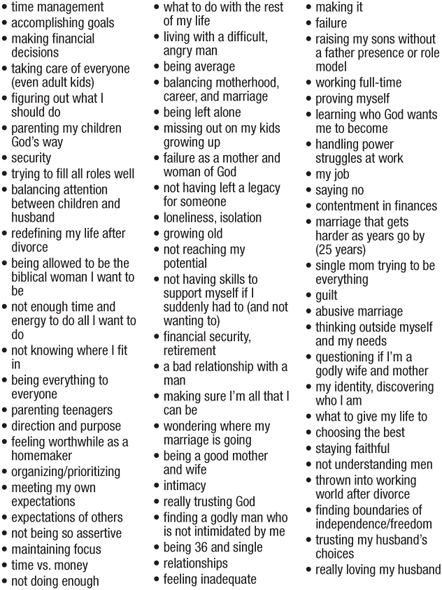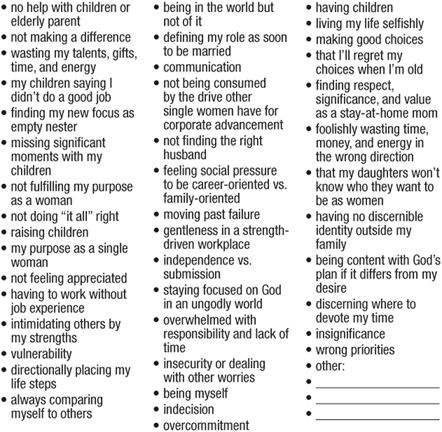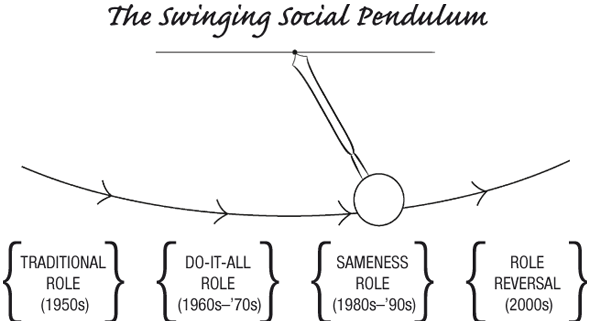The New Eve (5 page)
Authors: Robert Lewis

These moves are not hard to understand, but they require boldness and courageous faith to activate. More importantly, they unleash the best of this life. They have worked this way in many women's lives, and they will work in yours as well. We'll unpack the first of these bold moves in chapter 4. But first let's look at the major issues women are struggling with today—issues these bold moves are meant to resolve.
What the Issues Are
T
o be good at counseling, you must have the ability to distinguish between issues and problems. That's a gift of insight most people don't possess. To them, issues and problems look and feel the same. They are not. In fact, they are as different as cause and effect. Problems are nothing more than “surface eruptions”—usually generated by a deeper, less apparent, unresolved issue.
For instance, you may have trouble relating to a certain individual in your family or social group. You fight. You don't get along. You can't communicate. Those are very real and serious problems. But the real
issue
behind that struggle may actually be a secret jealousy they hold against you or the need you have (but won't admit) to control other people. Issues, you see, lie behind problems. I've seen people contend all their lives with one difficulty after another but never identify or address the issue actually fueling their problems.
It's easy to have this blind spot. I know because I've fallen prey to it firsthand. I once brought in a highly regarded consultant to help me with a number of serious problems I was having in leading our church. For several hours I poured out to him my frustrations with staff, organization, time demands, directional
challenges, and personal concerns. Honestly, I was really hurting. From time to time, he would ask probing questions to aid his understanding of my situation.
Eventually, I finished venting my list of nagging problems. I was eager to hear what ideas he would offer to help untie me from these leadership knots. Pen in hand, I prepared to take notes.
After a long pause he looked at me and said, “Robert, you're tired.” I quickly acknowledged that but waited for him to get down to real answers for solving my predicament.
But that
was
his answer.
With laserlike insight, he rightly named the issue behind all my troubles. And as the day went on, he helped me see that most of my current undoing was either exaggerated or self-inflicted because of exhaustion. The reason I was so overwhelmed and confused was simply because I was out of gas. “Fatigue makes cowards of us all,” he said. “What you need is some time off to recharge your batteries and put life back into perspective.”
At that moment time off was the last thing I thought I needed. But his advice proved to be on target. And by heeding his wise counsel and addressing this issue—not working harder or smarter on the problems resulting from it—I found the real leadership help I needed to get my life back together.
When I talk to women about their personal problems, I often get an earful. And that's a good thing. Unlike men, women on the whole are much more transparent and open about the things that trouble and concern them. Along with speaking to women personally, I've also had the opportunity to formally survey hundreds of women across our country. These surveys have helped me better identify and understand the specific problems women say they are facing.
On the next page I've provided for you a detailed list of the struggles these women have told me. Let me suggest that you
pause at this point and take your time looking this list over. Grab a pen or pencil and circle the hot phrases you can personally identify with. After you've completed this, we'll continue.
Problems Women Say They Struggle With
— Circle those that apply to you. —



The words you've just circled are your problems. But if I can play counselor for a moment, let me suggest that most of these problems, even as painful as some of them are, are not the
source
of your troubles. Most of what you and other women struggle with today actually springs
from five volatile issues
that often remain open and unresolved. And by remaining unresolved, they infect life with confusion and bad decision making. On the other hand, when these issues are addressed with biblical convictions (which we will do beginning in chap. 4), many of the problems flowing from them naturally work themselves out or can be successfully dealt with.
So what are the issues behind many of the problems swirling around and within the lives of women today? Let's take a look.
What does it mean to be a woman today? You would think such a basic question would be easy to answer. Think again. No commonly accepted answer exists. Certainly not one with biblical roots. Even the images
woman
brings to mind have morphed significantly over the last generation. Fifty years ago when you heard this word, you were more than likely to associate it with words like
soft, sensitive, submissive, nurturing, pretty
, and
virtuous.
Not so today. Words like
assertive, strong, confident, sexy, independent
, and
equal
have inserted themselves into the modern picture.
Added to this are new assertions of what it means
to be
a woman. Hillary Clinton set the tone for the new woman when she quipped on her husband's 1992 campaign trail that she was not about “to stay home and bake cookies” and “be some little woman standing by her man.” Actress Sharon Stone went ever further. She reportedly said, “As I see it, the choice today is between being feminine and equal. I choose equal.” Everywhere today new voices like this are redefining and reshaping what it means to be a woman.
As a Christian woman, you cannot help but be influenced by the sweeping sociological changes presently taking place. Indeed, in our postmodern world it's easy to think of being a woman as nothing more than a personal choice. But
if
you are a woman of faith, personal choice should first yield to deeper questions, such as: How does God define me as a woman? Is there a basic pattern for womanhood that supersedes my preferences and choices with divine call? I believe the Scriptures offer life-defining answers to such questions for any woman who has the ears to hear. But that's for later.
Here the issue is the significant status changes that have marked the lives of women since the 1950s. They have been as dramatic as the changes in women's hairstyles. While salons during this time moved from the beehive to Charlie's Angels to “the Rachel” and beyond, a woman's social identity has shifted as well from one role paradigm to another, as illustrated below.

Typified by the sitcoms of the 1950s, this was an era of Ozzie and Harriet, strict social decorum, well-defined and separated gender patterns, and patriarchal authority. Young girls played with dolls, put on practice teas, and paid close attention to etiquette. In school they studied hard enough, but very often their primary aim was to wed and have a family. The sooner, the better. Women who desired to pursue careers outside the home were rare. So were single women.
“A
woman's place is in the home” was the slogan that carried the day. That not only meant that a woman best served society by getting married and staying home with her children, but it also strongly implied that a woman should leave the broader world of professional ambitions to
men. This stereotype was spiritually endorsed by many churches as being
the
biblical model of what a woman should be, despite biblical examples to the contrary (Judg. 4:4; Prov. 31:16; Acts 16:14; 18:1–3, 26).
My mom went a different direction. She married late and continued to work full-time as the office manager of a law firm even after having three boys. And though she had to hire help to care for us when we were young, the close proximity of her office and the gentle pace of a small southern town allowed my mom to miss little, if any, of my adolescence. I never thought my mom wasn't there for me. She was. But she was also the exception as a working mother in the ’50s. Most women were stay-at-home moms.
Social mores were shattered in the radical ’60s and the psychedelic ’70s. In this era almost everything for a woman came into question: her role, her place, her value, her virginity, and even the sacred ground of marriage. Why not merely live together? It was a wild time of free love for many women and men, and some unfortunately paid for it later. But at this moment freedom from traditional restraints was intoxicating.
Married women were liberated too. They were told they could have it all, especially when it came to work and home. “If I have to, I can do anything. I am strong, I am invincible, I am woman,” proclaimed Helen Reddy in her hit song. From this age of idealism, the concept of the supermom was born. This idea, however, was short-lived. By the end of the ’70s, working moms were tasting the bitterness of reality and exhaustion that doing it all brings.
One such mom confessed to Oprah Winfrey, “I tried hard to be the supermom, but frankly I wasn't good at it. Looking back, it was costly. I had a very angry little girl who wanted her mommy,
and I didn't have the time, and I didn't know how to balance it. It took me a long time to understand that you can't have it all.”
1
And so as quickly as it had arisen, the supermom concept crumbled into the supermyth. But there was no going back to the ’50s. A new womanhood had been uncorked, and if supermom wasn't the answer, then something else was.
In the ’80s and ’90s a new form of femininity arose. One more realistic but also more aggressive and assertive. Women would no longer try to do it all. Instead, they would demand that men share every facet of life with them fifty-fifty. Away with gender distinctions at home, work, and play! Columbia University's Carolyn Heilbrun argued for this idea in her book
Reinventing Womanhood.
A husband's career should not take priority over his wife's, and his care-giving duties at home should match hers exactly, said Heilbrun. She justified her “symmetrical family” model on the claim that gender differences are a sociological contrivance, not the result of divine design. A mom's tender femininity reflects the manipulative forces of social persuasion, not her nature. And if men balk at being motherly, it's the culture, not nature, that's to blame. The no-roles sameness model was “scientific,” said the social critics, and “destined to be the dominant family form of the future.”
2